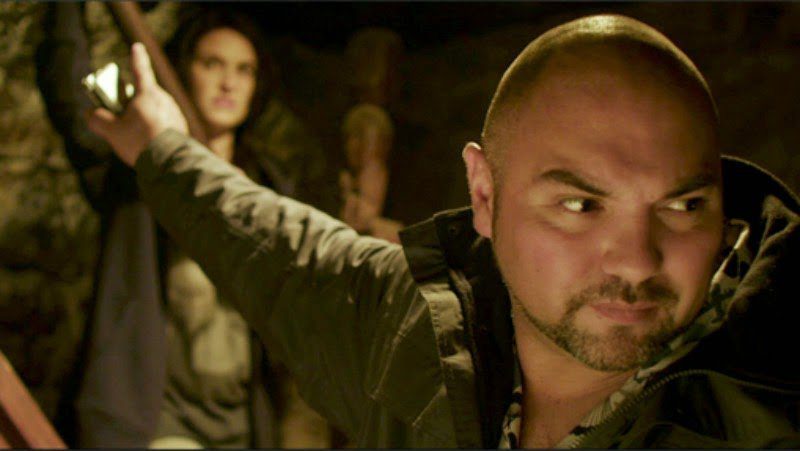“There are one or two occupants who have yet to leave the premises.”
I hadn’t intended doing any horror comedy this year, because, well, I like writing about horror more than I do about horror, and any review of a horror comedy comes with a nonzero chance of me comparing it to Cabin In the Woods (in my defense, that’s the best horror comedy ever made). Truthfully, the bloom had come off the rose for me and horror comedy. Even the better ones, like Tucker and Dale vs. Evil, have trouble with the tonal balancing act (to say nothing of the wretched Scream 3). So I was a bit surprised – not unpleasantly – to find that Housebound is as funny as it is. Mind you, it’s not like Midsommar, which is a horror film with funny moments. No, this is a straight-up horror comedy, despite what the description on Shudder would have you believe.
Kylie Bruckner is having a bad go of things. We first meet her and her partner in crime trying and failing to break into an ATM. The man swings at it with a sledgehammer, only to be immediately knocked out by it bouncing back at him. Kylie fares no better, taking off in the getaway car only to get stuck on a curb and subsequently arrested. She’s sentenced to eight months of house arrest at her mother’s house, which is an almost quaint punishment (also a sign that the New Zealand justice system is much more forgiving than ours). It might seem like a plot contrivance, but it also helps in the film’s world-building, as Housebound takes place in the present day while also feeling stuck in the past (shades of It Follows). Think landline phones and dial-up modems.
In a situation like this, the chemistry between Kylie and her mother, Miriam, is paramount. Theirs is a prickly relationship, most of which is caused by Kylie. In these opening scenes, Morgana O’Reilly plays Kylie as somewhat one-note: she’s sullen, rude, and flat-out mean. Of course that lays the foundation for growth, but I’d be lying if I said it didn’t make Kylie tough to root for. Luckily, Rima Te Wiata is terrific as Miriam. Te Wiata has the timing of a sitcom actress, and a dry, rapid-fire delivery of one-off jokes that invites comparison to Miranda Hart. (I’m now imagining a British remake of this with Hart as Miriam and Florence Pugh or Juno Temple as Kylie.)
What I’m describing so far sounds like an odd situational comedy, and yes, Housebound is that at times. But is it scary? Thankfully, the answer is (mostly) yes. What works best is the fundamental unknowability of the house itself; as the characters explore it further, they find passageways and tunnels they never suspected were there. The house’s history goes through some revision as well. In a lot of ways Housebound is about the folly of taking a surface-level view of things: maybe the man installing your ankle monitor will become your friend and partner; maybe the bearded maniac living in the walls is a lonely, wounded soul who just wants to be left alone. And maybe the creepy-looking neighbor is gruff yet well-meaning.
Your mileage really may vary with Housebound. I watched this with a friend and neither one of us knew it as anything other than a horror movie; halfway through they looked at me and asked, “This is a bad movie, right?” I did and do disagree, but that’s beside the point. The trouble with horror comedies is that either the jokes don’t land or the tone is too light for the scares to have any effect. Occasionally that’s the case here, as in certain scenes Housebound turns into a madcap farce before quickly switching to something more in the line of Grand Guignol. If nothing else, it’s an incredibly bold attempt by writer/director Gerald Johnstone.
Johnstone uses everything in a horror director’s bag of tricks to convey a sense of dread and menace. That some of these seem like in-jokes and some seem sincere is a testament to how well Housebound can at times blend genres. Sometimes it has the staging of a play, as a good portion of the film just involves characters entering or exiting different rooms of the house. (This comes to a head in a parlor sequence near the climax, which is just straight-up farce.) Can the movie, then, create a villain that is still able to be scary?
I say yes. The final chase sequence is a long one, arduous even, and that’s to the film’s benefit. There are a couple of funny moments (two of which are of the laugh-out-loud variety), but Johnstone knows when to take things seriously. There are some bloody moments as well, and one character gets covered in a spray of bright-red blood that wouldn’t be out of place in a Dario Argento movie. But as Kylie and Miriam fight and run for their lives, O’Reilly and Te Wiata are committed enough to make their terror and resilience real.
If you’re looking for a horror movie, Housebound might strike you as a bit of a mixed bag. It’s funnier than it is scary, but the scares that work, work quite well. See, this is why I didn’t want to write about horror comedy this year! It’s a tough genre to make and a tough one to write about. Put it this way: hours after watching the movie, I remember the jokes as well as I remember the scares. That’s probably the highest praise I can give it.



